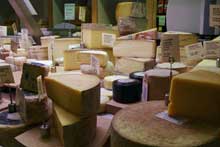 Cheese-makers in Scotland are still permitted to use unpasteurised milk in their cheese-making, and most of the really excellent cheeses on the market are made from unpasteurised milk.
Cheese-makers in Scotland are still permitted to use unpasteurised milk in their cheese-making, and most of the really excellent cheeses on the market are made from unpasteurised milk.
The oldest type of Scottish cheese is crowdie. A curd cheese, made from cows’ milk, crowdie has been made in the Highlands and Islands since before the Vikings. Crowdie has always been made domestically, but in 1962 Reggie and Susannah Stone began to make it commercially, from their herd of Shorthorns, near Tain.
Crowdie used to be made by putting the container of fresh milk beside the heat on the kitchen range or in the sun, until the milk soured. The natural souring of the fresh (unpasteurised) milk gave crowdie its citric, lemony taste. The Stones made the best-known form of a rich creamy cheese, rolled in oatmeal, called caboc - one of the earliest-made of the many excellent Scottish cheeses of the past four decades.
These days, crowdie is usually made from pasteurised milk. Pasteurised milk doesn’t sour naturally - it just goes bad. To start the crowdie-making process, lactic acid is added to the milk, but from then on crowdie is made as it has always been - when the milk has formed curds with the consistency of scrambled eggs, these are mashed, mixed with salt and double cream and then hung in a muslin to let the whey drip off.
There are superb cheeses being made throughout Scotland from cows’, sheep’s and goats’ milk. Cheeses which are soft and creamy, blue-veined and hard, cheddar types. The Isle of Mull cheddar cheese was recognised for its excellence and won an award on a Radio 4 food programme at the end of 2002. This cheddar is the one we have bought for many years, to be a part of the cheese display on the sideboard in the dining-room here at Kinloch for our guests, and this, too, is the cheese we cook with.
Cheese is an integral part of cooking. So many savoury dishes rely on cheese as an ingredient - a simple cheese sauce, for example, can be made to serve spooned over vegetables ranging from broccoli to leeks, or as a sauce accompanying fish, or it can form the basis for a soufflé which is not the difficult dish in its construction that people often suppose it to be. But where cheese is called for as an ingredient, it is important to use the best you can find. And to underline its flavour you can add, for instance, a couple of teaspoons of Dijon mustard to the sauce - it won’t taste of mustard, but the cheese is emphasised.
An excellent range of cheese can be found in specialist food shops throughout Scotland, but most notably in the Gourmet’s Lair, in Inverness, in the House of Bruar just north of Blair Atholl, and Valvona and Crolla in Edinburgh. Among the very many other shops which sell cheeses must be mentioned Mrs McDonald’s shop in Blairgowrie, which has been selling wonderful cheese for even longer than the others. Ian Mellis, the renowned cheese merchant, has excellent shops in Edinburgh and Glasgow.
点击查看本频道更多精彩内容